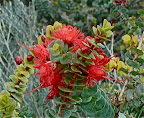 |
| From Verticordia grandis |
Sometimes I change my plans. Rarely I change my mind. But to change a heart is something unique and rare. Verticordia means “Changer of Hearts” in Latin and this plant is named Verticordia after the goddess Venus of whom it was said was so beautiful she could change a persons heart with a glance.
This particular flower is from Verticordia grandis which is the only Verticordia species that is blooming in the garden right now. There are several other species that are commonly referred to as “featherflower” and I’ll try to post some pics of them as they start to show off in the spring. The common name for V. grandis is “Scarlet Featherflower.”
Even without flowers, the scarlet featherflower would be a show piece. It is a shrub, normally about 4-5 ft high but can grow to 12 ft. It is endemic to a small area just north of Perth and up to Geraldton. In the wild it can be wiry, short and unimpressive, but here in the botanical garden where it is pampered it is always a point of interest.
 |
| From Verticordia grandis |
The main stems are blood red when they are young and they provide support for hundreds of strangely pale green leaves attached directly without a separate leaf stem. There are two leaves at each connection and each connection is offset from its nearest neighbor by 90 degrees which gives the leaves the appearance of surrounding the stem in a continuous spiral. Each leaf is also edged by a blood red outline encircling the leaf.
Touching a leaf here is almost always surprising because what looks soft is often hard, and vice versa. These leaves are soft to the touch, not quite like velvet, but not like a normal shrub leaf either.
Despite the beauty of the stems and leaves, the flowers of the Verticordia grandis are the real attraction. It is called a featherflower because the calyx lobes are fringed. The Calyx of a flower is the group of sepals that support the petals from underneath. Normally in the US and most of the rest of the wold, the sepals are green, but here in Australia, all bets are off and in the scarlet featherflower they are the same red color as the petals. The five petals are inside the calyx and they are fused together to form a tube. Insects travel down this tube in search of nectar and they collect pollen along the way to be used to fertilize next flower they visit. On some flowers you can see a long thin red spike curving out from the calyx and that spike is the style that contains the stigma on its end.
 |
| From Verticordia grandis |
The featherflowers, like all plants in WA are susceptible to fire. Many plants here require fire to multiply with their seeds laying dormant for years until the fires come. But for the featherflower seeds germinate normally without fire. When fire does come, the Verticordia regenerates by sprouting new stems from lignotubers just underground.
No comments:
Post a Comment